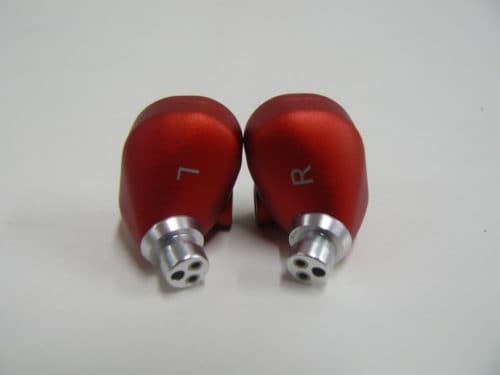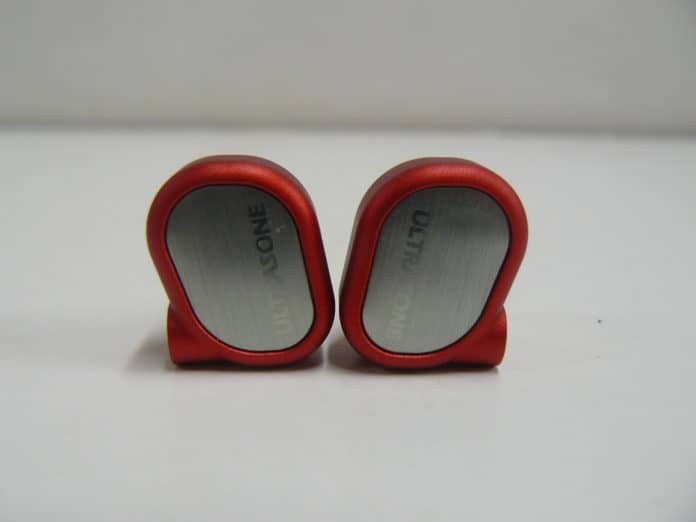Ultrasone has impressed me with its multiple lines of over-ear headphones. They have a striking sense of fidelity that fills its sound signature with pleasing textures, and amusing coloration. Recently Ultrasone released a limited edition Sunrise version of their Ruby IEM. The Ruby is a major collector IEM, and the most devout listeners will want a piece no matter how they sound. However, is the Ruby just a collector’s item, or is it a must by IEM that can compete with Ultrasone’s standard quality in headphone design.

What You Get
The Ruby comes with your standard IEM fair, zipper case, detachable cable, ear tips, and all that. The earpieces themselves are protected by inserts, and the cable can be located in a small drawstring bag. There are six sets of ear tips, three foam, and 3 silicone in a few optional sizes. Ultrasone also includes a cleaning tool because you have dirty ears and they know it.

Look and Feel
I thought this was an odd shape for an IEM to take. It’s funny because the rounded rectangle edges are so uniquely Ultrasone that they wouldn’t even need to put their logo on the plate and you’d still know it’s them. The earpieces resemble a shrunken down earcup of one of Ultrasone’s mainline headphone models like the ED15. The silver plate shell is a nice touch, and the aluminum housing keeps these IEMs durable, and ready for long hours of listening. I used the medium-sized silicone ear tips, and I thought they felt secure in my ears most of the time. The nozzle is just the right size so that the housing can sit sturdily in the shape of your ear. It’s a feeling you get used to right away, especially if you’re familiar with most IEMs of this stature.

Design
Seeled inside this thick aluminum housing is a six-driver system with four-way hybrid technology. Each earpiece contains two balanced armatures meant for producing bass frequencies and two BA drivers for mid and high range output. Ultrasone has also included two supplemental electrostatic systems to act as supper tweeters, as a way to extend high range information for additional detail. I find it fascinating Ultrasone would put so much work into making their highs the main event of the Ruby when usually it’s the lows that receive most of the limelight. It’s apparent that Ultrasone is crafting a specific experience that may not appease all, but an inclusion the die-hard collector might better appreciate.

Output
In terms of accessibility, the Ruby seeks to provide a sustainable signal throughout a multitude of devices. The Ruby has a sound pressure level of 106dBSPL and an impedance of 25 Ohms. This IEM will have no problem driving signal to your PC headphone jack, or smart device. I’d still recommend an amp for these guys, as the Ruby has a frequency response of 10Hz-50kHz and that expression of detail will be easier to come by to make the best out of these IEMs.
Soundstage
The extent of this stage kept surprising me with each new track I tested. New elements made themselves clear within the sound field, as the amount of space grew further and further not seeming like it was going to stop at any point. The sonic elements themselves felt a little too surface level, but the image is massive for an IEM. The electrostatic drivers that Ultrasone added to the Ruby create a sense of space in the highs, as the mids and lows flow with each other, creating an overall warm timbre with crisp high-end detail. I found myself listening to B. Lustford and Robert Rich’s Stalker concept album, which features a lot of dark ambiances that require an ample amount of space that the Ruby was able to bring. Rock and pop tracks spread out the instrumentals with precision, and exposed elements otherwise hidden in the mix, such as small harmonies or dissipating cymbal crashes.
Low End
There are a few things the lows do exceptionally well, and a few things that could be improved upon. The bass frequencies posses an enveloping nature that boosts this IEM in terms of power. Thumping trap beats feel punchy, and bass strings hold a significant amount of heft to them. The width of the response is notable, but these are not the smoothest textures you’ll find, and the lows start to lose a bit of focus toward the mid bands.
Mids
The mid-range is full of interesting textures, and odd hollow areas. The low mids provide some gain and create a warm timbre that ends up bloating some of the space in this area. This isn’t an IEM for blasting hard rock tracks as it seems, but folkier tracks do present that warmness as a better space for these textures. As the mids start to climb in the frequency spectrum, clarity starts to improve greatly. Vocal performances at this register are ferociously intimate, such as on the demo versions of Geroge Harrison’s “Awaiting On You All” which feels as if God is singing right to you. While were on how awesome Geroge Harrison is, I also tested the track “Here Comes The Moon” which included some rich acoustic and clean electric guitar performances that the Ruby soaks itself in.
Highs
By now you’re probably dying to know how good these electrostatic drivers sound, and the answer, unsurprisingly, is just wonderful. I mentioned George Harrison’s “Here Comes the Moon” while talking about the highs, and that same track has these chimes toward the beginning that sparkles and dissipates in a pleasing aural fashion. These highs have sizzle and provide tracks with a shiny coat of paint. Acoustical details shimmer and dissipate in a spacious soundscape that heightens the presence of each track
Summary
The Ruby has a lot going for it. For a collector, it’s probably a no brainer, but if you were looking to settle down with a prestigious IEM, is this the one? I don’t think I would be too confident with that. While the Ruby has a lot of admirable qualities, it’s not a very versatile sound signature. It’s not a sound looking to satisfy every genre, so it really just depends on what you’re listening too. The Ruby handles various sounds fairly well, but for the $2499.99 price point its tough to recommend completely if you’re not a collector.

Pros and Cons
Pros: Crisp highs, durable design, good fit
Cons: Price
Ultrasone Ruby Sunrise available for a limited time from Audio 46
MAJORHIFI may get a commission from retail offers.
MAJORHIFI may receive commissions from retail offers.








